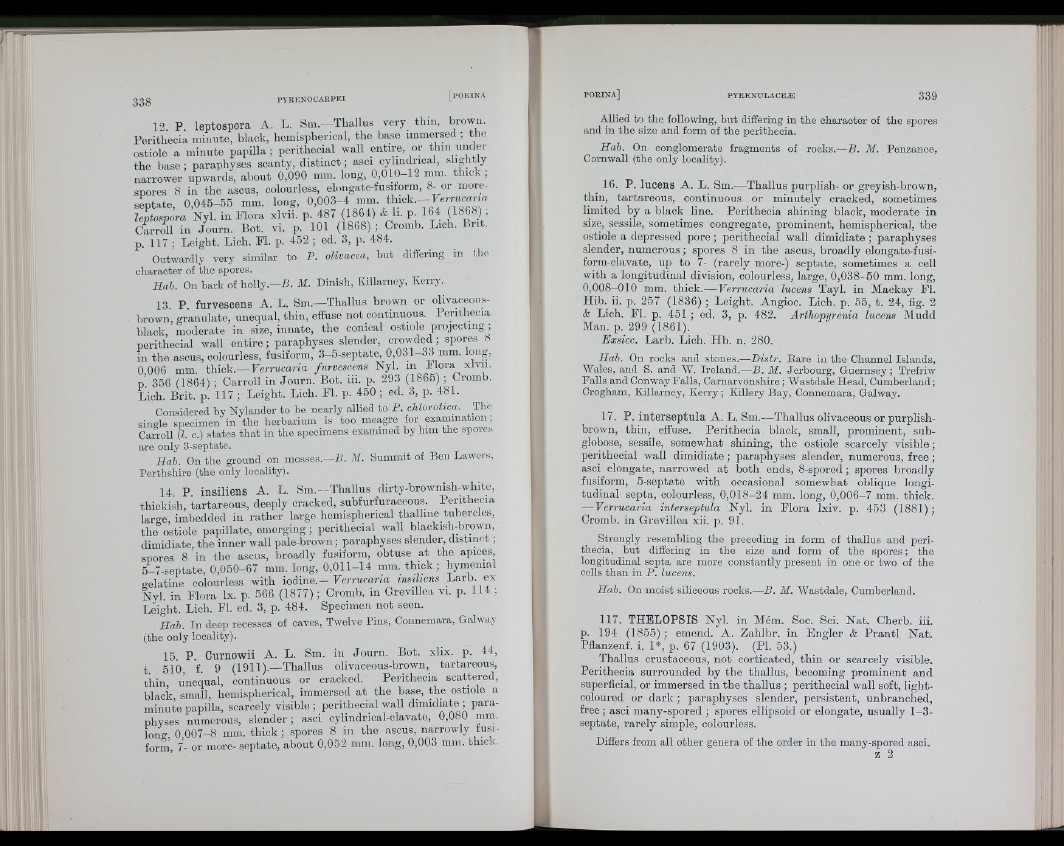
12. P. leptospora A. L. Sm .-T h a llu s very thm, browii.
Perithecia minute, black, hemispherical, the base immersed ; the
ostiole a minute papilla; peritheciai wall entire, or thm under
the b a se ; paraphyses scanty, d is tin c t; asci cylindrical, slightly
narrower upwards, about 0,090 mm. long, 0,010-12 mm. thick ;
spores 8 in the ascus, colourless, elongate-fusiiorm, 8- or more-
s l t a t e , 0,045-55 mm. long, 0,003-4 mm. t h c k . - f e r ^ ^
leptospora Nyl. in Mora xlvii. p. 487 (1864) & li. p. 164 (1868)
Carroll in Journ. Bot. vi. p. 101 (1868) ; Cromb. Lich. Lrit.
p. 117 ; Leight, Lich. FL p. 452 ; ed. 3, p. 484.
Outwardly very similar to P. olivácea, but differing in the
character of the spores.
Hab. On bark of holly.—R. M. Dinish, Killarney, Kerry.
13 P furvescens A. L. Sm.—Thallus brown or olivaceous-
brown, granulate, unequal, thin, effuse not continuous. Perithecia
black, moderate in size, innate, the conical ostiole projecting;
peritheciai wall e n tire ; paraphyses slender, d'owded; spores S
in the ascus, colourless, fusiform, 3-5-septate, 0,031-33 mm. long,
0,006 mm. thick.—Ferracaria furvescens Nyl. m Mora xlvii.
p 356 (1864); Carroll in Journ. Bot. iii. p. 293 (1865); Cromb.
Lich. Brit. p. 117; Leight. Lich. Fl. p. 450 ; ed. 3, p. 481.
Considered by Nylander to be nearly allied to P. chtoroUca. The
single specimen in the herbarium is too meagre for examination ;
Carroll [1. c.) states that in the specimens examined by him the spores
are only 3-septate.
Hah. On the ground on mosses.—B. M. Summit of Ben Lawers,
Perthshire (the only locality).
14. P. insiliens A. L. Sm .-T h a llu s dirty-brownish-white,
thickiéh, tartareous, deeply cracked, subfurfuraceous. Perithecia
large, imbedded in rather large hemispherical tliallme tubercles,
the ostiole papillate, emerging; peritheciai wall blackish-brown,
dimidiate, the inner wall pale-brown; paraphyses slender, d is tm c t,
spores 8 in the ascus, broadly fusiform, obtuse a t the apices,
5U-septate, 0,050-67 mm. long, 0,011-14 mm. th ic k ; hymenial
o-elatine colourless with io d in e .- F e r r w r a n a msihens Larb. ex
Nyl. in Flora Ix. p. 566 (1877) ; Cromb. in Grevillea vi. p. 114 ;
Leight. Lich. Fl. ed. 3, p. 484. Specimen not seen.
Hah. In deep recesses of caves. Twelve Pins, Connemara, Galway
(the only locality).
15 P. Curnowii A. L. Sm. in Journ. Bot. xlix. p. 44,
t 510 f. 9 (1911)-—Thallus olivaceous-brown, tartareous,
thin, unequal, continuous or cracked. Perithecia scattered,
black, small, hemispherical, immersed a t the base, the ostiole a
minute papilla, scarcely visible ; peritheciai wall dimidiate ; paraphyses
numerous, slender; asci cylindrical-clavate, 0,080 mm.
long 0 007-8 mm. th ic k ; spores 8 in the ascus, narrowly fusiform
7- or more- septate, about 0,052 ram. long, 0,003 mm. thick.
Allied to the following, but differing in the character of the spores
and in the size and form of the perithecia.
Hab. On conglomerate fragments of rooks.—B. M. Penzance,
Cornwall (the only locality).
16. P. lucens A. L. Sm.—Thallus purplish- or greyish-brown,
thin, tartareous, continuous or minutely cracked, sometimes
limited by a black line. Perithecia shining black, moderate in
size, sessile, sometimes congregate, prominent, hemispherical, the
ostiole a depressed p o re ; peritheciai wall dimidiate; paraphyses
slender, numerous; spores 8 in the ascus, broadly elongate-fusi-
form-clavate, up to 7- (rarely more-) septate, sometimes a cell
with a longitudinal division, colourless, large, 0,038-50 mm. long,
0,008—010 mm. thick.— Verrucaria lucens Tayl. in Mackay FI.
Hib. ii. p. 257 (1836); Leight. Angioc. Lich. p. 55, t. 24, fig. 2
& Lich. Fl, p, 451; ed. 3, p. 482. Arthopyrenia lucens Mudd
Man. p. 299 ^ 8 6 1 ).
Exsicc. Larb. Lich. Hb. n. 280.
Hab. On rocks and stones.—Distr. Eare iu the Channel Islands,
Wales, and S. and W. Ireland.—B. M. Jerbourg, Guernsey ; Trefriw
Palls and Conway Falls, Carnarvonshire; Wastdale Head, Cumberland;
Crogham, Killarney, Kerry; Killery Bay, Connemara, Galway.
17. P. in te rsep tu la A. L. Sm.—Thallus olivaceous or purplish-
brown, thin, effuse. Perithecia black, small, prominent, subglobose,
sessile, somewhat shining, the ostiole scarcely visible;
peritheciai wall dimidiate; paraphyses slender, numerous, fr e e ;
asci elongate, narrowed a t both ends, 8-spored; spores broadly
fusiform, 5-septate with occasional somewhat oblique longitudinal
septa, colourless, 0,018-24 mm. long, 0,006-7 mm. thick.
— Verrucaria interseptula Nyl. in Flora Ixiv. p. 453 (1881);
Cromb. in Grevillea xii. p. 91.
Strongly resembling the preceding in form of thallus and perithecia,
but differing in the size and form of the spores; the
longitudinal septa are more constantly present in one or two of the
cells than in P. lucens.
Hah. On moist siliceous rocks.—B. M. Wastdale, Cumberland.
117. THELOPSIS Nyl. in Mém. Soc. Sci. Nat. Cherb. iii.
p. 194 (1855) ; emend. A. Zahlbr. in Engler & P ra n tl Nat.
Pflanzenf. i. l* ,'p . 67 (1903). (PI. 53.)
Thallus crustaceous, not corticated, th in or scarcely visible.
Perithecia surrounded by the thallus, becoming prominent and
superficial, or immersed in the thallus ; peritheciai wall soft, light-
coloured or dark ; paraphyses slender, persistent, unbranched,
free ; asci many-spored ; spores ellipsoid or elongate, usually 1-3-
septate, rarely simple, colourless.
Differs from all other genera of the order in the many-spored asci.
z 2